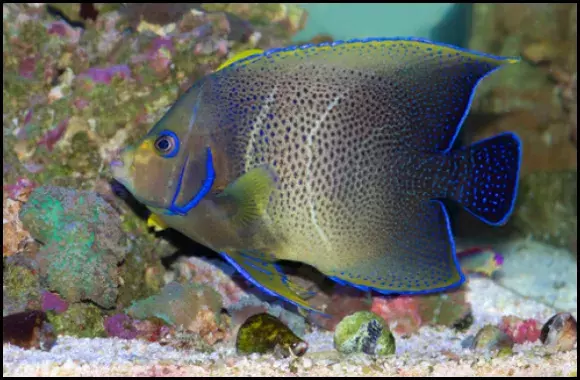
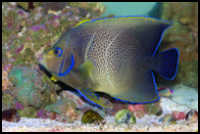
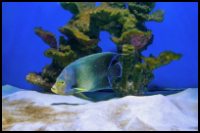
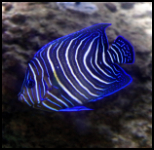
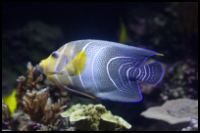
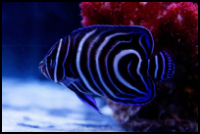
Quick Care Details (Table)
| Livestock Characteristics | Value |
|---|---|
| Care Level | Moderate |
| Temperament | Semi-Aggressive |
| Diet | Omnivore |
| Maximum Size | 1ft & 3 Inches |
| Minimum Tank Size | 200 Gallons |
| Reef Compatible | No |
| Temperature Range | 72-78F |
| PH Range | 8.1-8.4 |
| DKH Range | 8-12 |
| Salinity Range | 1.020-1.025 |
Species Specific Categories
Helpful Video
Care Details
Aquascape:
- The Koran Angelfish's Habitat and Aquascape Preferences
- Designing the Aquarium with Live Rock and Open Spaces
- Considerations for Coral Compatibility
Substrate:
- Choosing the Right Substrate for the Koran Angelfish
- Benefits of Fine to Medium-sized Sand Substrate
- Accommodating Burrowing Behavior
Disease Prevention:
- Quarantine Measures for New Additions
- Importance of Excellent Water Quality
- Vigilance in Monitoring Fish Health
Filtration:
- Proper Filtration for Water Quality
- Balancing Mechanical, Biological, and Chemical Filtration
- Maintaining Stable Water Parameters
Lighting:
- Providing Suitable Lighting for the Aquarium
- Supporting Live Rock and Macroalgae Growth
- General Lighting Recommendations
Water Flow:
- Water Flow Preferences of the Koran Angelfish
- Gentle Currents to Mimic Natural Reef Environments
- Using Powerheads or Circulation Pumps
Hardiness:
- Understanding the Koran Angelfish's Hardiness
- Adapting to a Range of Water Parameters
- Ensuring Stable and Clean Water Conditions
Acclimation:
- Proper Acclimation Process for New Koran Angelfish
- Gradual Adjustment to New Water Conditions
- Reducing Stress and Shock
Special Requirements:
- Coral Nipping Behavior and Reef Tank Considerations
- Providing Hiding Spots and Territories with Live Rock
- Compatibility with Tank Mates
Temperament and Behavior
Behavior and Social Interaction:
- The Koran Angelfish's Natural Behavior in the Wild
- They are typically found in small groups or pairs in their natural reef habitats.
- Koran Angelfish are active swimmers, often patrolling their territory and exploring their surroundings.
- They may interact with cleaner fish to have parasites removed, exhibiting mutualistic behavior.
- Observing Social Interaction in Captive Environments
- In captivity, Koran Angelfish may display individual personalities, with some being more territorial and aggressive than others.
- They may establish territories within the aquarium, especially if kept with similarly-shaped species.
- Social interaction between Koran Angelfish can include courtship displays, swimming together, or occasional aggression.
- Understanding Individual Personalities
- Some Koran Angelfish may be more docile and peaceful, while others can be more dominant and aggressive.
- The fish's behavior can be influenced by factors such as tank size, tank mates, and available hiding spots.
- Spending time observing each individual can help aquarists identify unique traits and behaviors.
Aggression:
- Assessing the Koran Angelfish's Aggressive Tendencies
- Koran Angelfish can exhibit territorial behavior, especially when kept with other angelfish or similarly-shaped species.
- They may become more aggressive during feeding times or when defending their territory.
- Factors that Trigger Aggressive Behavior
- Overcrowding, limited hiding spots, or competition for food can trigger aggression.
- Introducing new tank mates without proper acclimation or territory preparation can lead to confrontations.
- Managing Aggression in the Aquarium
- Provide ample hiding spots and visual barriers using live rock to reduce aggressive encounters.
- Avoid keeping multiple angelfish in smaller tanks, as space constraints can exacerbate territorial behavior.
- Monitor the aquarium regularly and be prepared to separate aggressive individuals if necessary.
Breeding:
- Challenges and Rarity of Breeding Koran Angelfish in Captivity
- Breeding Koran Angelfish in captivity is considered rare due to their complex breeding requirements.
- Successful breeding often occurs in large, mature, and well-maintained aquariums.
- Overview of Spawning Behavior and Courtship Rituals
- Koran Angelfish typically engage in a courtship ritual that involves swimming together and displaying colors.
- Spawning involves the release of eggs and sperm into the water column, where fertilization takes place.
- Providing the Right Conditions for Breeding Success
- Creating a suitable environment with appropriate hiding spots for the eggs is crucial.
- The availability of compatible mates and the right water parameters are also important for successful breeding.
Compatibility:
- Choosing Suitable Tank Mates for the Koran Angelfish
- Select peaceful and non-aggressive species that can tolerate the occasional territorial behavior of the Koran Angelfish.
- Avoid keeping them with other large angelfish or similarly-shaped aggressive species.
- Potential Conflicts with Similarly-shaped Species
- Koran Angelfish may perceive other angelfish or butterflyfish as competitors for territory and food.
- Aggressive interactions can lead to stress, injuries, or even fatalities.
- Ideal Companions for a Peaceful Community Aquarium
- Consider peaceful reef-safe fish species like tangs, wrasses, or smaller peaceful damselfish as potential tank mates.
- Non-territorial and bottom-dwelling species can also be good companions for the Koran Angelfish.
Activity Level:
- The Koran Angelfish's Activity Levels in the Aquarium
- They are generally active swimmers, patrolling the tank and exploring their environment throughout the day.
- Sometimes they may rest on the substrate or among the rocks.
- Factors Affecting Activity and Exploration
- The presence of hiding spots and sufficient swimming space can encourage exploration and activity.
- Environmental changes, water quality issues, or stress can temporarily affect their activity levels.
- Promoting Natural Behaviors through Aquascape and
- Creating an aquascape that mimics their natural reef environment can encourage natural behaviors.
- Providing a varied and balanced diet with high-quality foods supports their overall health and activity levels.
Clean up Crew:
- The Role of the Koran Angelfish in Maintaining the Aquarium's Cleanliness
- Koran Angelfish may nibble on algae and detritus, contributing to the tank's overall cleanliness.
- While they can help control some algae, they are not as efficient as dedicated algae-eating fish.
- Impact on Algae Control and Detritus Consumption
- They are more likely to consume soft and filamentous algae rather than tougher types.
- Their cleaning behavior can reduce the need for manual algae removal but should not be solely relied upon for algae control.
- Potential Interaction with Other Clean up Crew Members
- Koran Angelfish may coexist peacefully with other members of the "clean up crew," such as certain snails and small hermit crabs.
- However, be cautious if the angelfish displays aggressive behavior towards these tank inhabitants.
Schooling or Shoaling Behavior:
- Understanding Schooling and Shoaling Behavior in Fish
- The Koran Angelfish is not known for forming traditional schools or shoals.
- In the wild, they are generally found as solitary individuals, in pairs, or small groups.
- Observing Group Behavior of Juveniles and Adults
- Juvenile Koran Angelfish may be more sociable and tolerate each other's presence.
- However, as they mature, they tend to become more territorial and aggressive.
- Whether Koran Angelfish Exhibit Schooling Tendencies
- In captivity, they are unlikely to exhibit true schooling behavior.
- While juveniles may swim together, adults usually establish their own territories and maintain some distance from each other.
Diet and Nutrition
Dry Foods:
- Dry foods for the Koran Angelfish include high-quality flakes, pellets, and granules.
- Look for products that are specifically formulated for marine angelfish or omnivorous marine species.
- Dry foods should provide a balanced diet with essential nutrients and vitamins.
Frozen Foods:
- Frozen foods are an excellent option to add variety to the Koran Angelfish's diet.
- Offer frozen mysis shrimp, brine shrimp, and krill as part of their feeding regimen.
- These foods retain their nutritional value and are usually rich in protein.
Live Foods:
- Live foods can be a valuable supplement to the Koran Angelfish's diet.
- Provide live brine shrimp, copepods, and daphnia to promote natural feeding behaviors.
- Culturing live foods at home ensures a constant supply of nutritious options.
Vegetables:
- While primarily omnivores, Koran Angelfish may consume some vegetable matter in the wild.
- Offer blanched and finely chopped vegetables like spinach, zucchini, and seaweed (nori) for added variety.
- Vegetables provide essential fiber and other nutrients.
Algae:
- In the wild, the Koran Angelfish grazes on various types of algae.
- Provide natural algae growth on live rocks or introduce marine algae sheets to replicate this aspect of their diet.
- Algae consumption helps supplement their diet with vitamins and minerals.
Feeding Schedule:
- Feed the Koran Angelfish multiple times a day in smaller portions, simulating natural grazing behavior.
- A typical feeding schedule may include 2-3 feedings per day.
- Be cautious not to overfeed, as it can lead to water quality issues and health problems.
Supplemental Foods:
- Supplemental foods enhance the overall diet and provide essential nutrients.
- Vitamin-enriched foods can be useful for bolstering the fish's immune system.
- Calcium-rich supplements may be beneficial for maintaining healthy bone structure and preventing issues like head and lateral line erosion.
Tank Parameters
Tank size:
- The recommended minimum tank size for a single Koran Angelfish is around 180 gallons (680 liters).
- A larger tank, such as a 250-gallon (946 liters) or more, is even better to provide ample swimming space and reduce territorial behavior.
- Keeping them in smaller tanks may lead to stress, aggression, and hinder their overall well-being.
Tank Length and Measurements:
- A suitable tank for the Koran Angelfish should have dimensions that provide enough horizontal swimming space.
- Ideal tank dimensions are typically at least 6 feet (1.8 meters) in length, 2 feet (0.6 meters) in width, and 2.5 feet (0.75 meters) in height.
The Species Maximum Size:
- The Koran Angelfish can grow up to approximately 14 inches (35 cm) in length.
- When planning tank size and tank mates, consider the maximum size to ensure they have enough space to thrive.
Water Temperature:
- The ideal water temperature for the Koran Angelfish is around 72°F to 78°F (22°C to 26°C).
- Avoid extreme temperature fluctuations, as they can stress the fish and compromise their health.
pH (Acidity/Alkalinity):
- Maintain the pH level in the range of 8.1 to 8.4 for the Koran Angelfish.
- Sudden and significant changes in pH should be avoided, as they can lead to stress and health problems.
KH (Carbonate Hardness):
- Aim for a KH level of 8 to 12 dKH (144 to 215 ppm).
- Carbonate hardness helps stabilize pH and prevent rapid fluctuations.
GH (General Hardness):
- The recommended GH level for the Koran Angelfish is around 8 to 12 dGH (143 to 215 ppm).
- General hardness contributes to the overall water quality and can impact fish health.
Nitrate (NO3) levels:
- Keep nitrate levels as low as possible, ideally below 10 ppm.
- Regular water changes and proper filtration help control nitrate levels and maintain water quality.
Salinity:
- The Koran Angelfish is a marine species, so it requires a salinity level of 1.020 to 1.025 specific gravity (sg).
- Use a reliable hydrometer or refractometer to measure and maintain salinity.
Phosphate (PO4):
- Ideally, phosphate levels should be kept below 0.03 ppm (mg/L).
- High phosphate levels can contribute to algae overgrowth and affect coral health.
Calcium (Ca):
- Maintain calcium levels between 400 to 450 ppm.
- Adequate calcium is essential for the growth of coral and other calcifying organisms.
Alkalinity (dKH):
- Aim for alkalinity levels of 8 to 12 dKH (144 to 215 ppm).
- Stable alkalinity is vital for coral health and pH buffering.
Magnesium (Mg):
- Maintain magnesium levels around 1200 to 1350 ppm.
- Proper magnesium levels support coral growth and metabolic processes.
Iodine (I):
- Keep iodine levels stable around 0.04 to 0.06 ppm (mg/L).
- Iodine is essential for the health of invertebrates and crustaceans.
History, Popularity, History and Species Variety Details
The History, Popularity and Habitat
History of the Koran Angelfish:
The Koran Angelfish (Pomacanthus semicirculatus) is a fascinating marine species that belongs to the family Pomacanthidae. It was first described by the French zoologist Bernard Germain de Lacépède in 1802. The species is also commonly known as the Semicircle Angelfish due to the distinctive semicircular pattern on its body.
The Koran Angelfish is native to the Indo-Pacific region, ranging from the Red Sea and East Africa to the waters of the western Pacific, including Indonesia, the Philippines, and northern Australia. It inhabits coral reefs, rocky outcrops, and lagoons, where it finds shelter and food amidst the intricate structures of living corals.
Popularity of the Koran Angelfish:
The Koran Angelfish is highly regarded in the aquarium trade for its striking appearance and unique coloration. Its beauty is further accentuated by a captivating pattern of electric blue lines and bright orange-yellow accents that run along its body. This stunning combination of colors and patterns has made the Koran Angelfish a highly sought-after addition to saltwater aquariums.
Due to its attractiveness and relative availability in the aquarium trade, the Koran Angelfish has gained popularity among hobbyists and aquarists with established marine setups. However, it's important to note that this species requires an adequately sized aquarium with proper environmental conditions to thrive.
Habitat and Natural Environment:
In the wild, the Koran Angelfish inhabits coral-rich regions of shallow tropical reefs and lagoons. They are typically found in pairs or small groups, and juveniles may occasionally form loose schools. These fish are closely associated with reef structures, where they can find shelter among corals, crevices, and rocky formations.
Their natural habitat is abundant with live corals and algae, providing a varied diet that includes zooplankton, small crustaceans, and algae. The intricate coral formations offer hiding places and protection, which is crucial for the Koran Angelfish's safety and well-being.
The reef ecosystem in which the Koran Angelfish thrives is a delicate balance of biodiversity, and their presence serves a significant role in maintaining the ecological equilibrium. In aquariums, providing an environment that replicates these conditions is vital to their health and happiness.
are there any variations of this fish?
Common Tank mates
- Tangs and Surgeonfish: Some tangs, particularly peaceful and non-aggressive species, can be good tank mates. Avoid more aggressive tangs that may compete for territory.
- Butterflyfish: Peaceful butterflyfish can coexist with the Koran Angelfish. Select species that have different color patterns to minimize aggression.
- Large Angelfish (other than similarly-shaped species): Some larger angelfish, such as the Emperor Angelfish (Pomacanthus imperator) or Regal Angelfish (Pygoplites diacanthus), may work well in larger aquariums.
- Wrasse: Peaceful wrasse species that are compatible with angelfish can be suitable tank mates.
- Fairy Wrasses: Smaller and peaceful fairy wrasses can add color and activity to the aquarium without posing a significant threat to the Koran Angelfish.
- Damsels: Some small and peaceful damselfish may work well in larger tanks. However, avoid highly territorial or aggressive damsels.
- Clownfish: Peaceful species of clownfish may coexist with the Koran Angelfish, especially in larger aquariums with sufficient space and hiding spots.
- Cardinalfish: Some cardinalfish species are relatively peaceful and can be good tank mates.
- Gobies: Certain gobies, particularly those that spend most of their time near the substrate, can be compatible with the Koran Angelfish.
- Anthias: Peaceful anthias species can add color and movement to the tank, and they usually occupy different areas in the water column.
Juvenile vs Adult Koran Angelfish
Juvenile Koran Angelfish:
- Juveniles have a predominantly black coloration with striking electric blue and bright white concentric circles on their body. These circles resemble the appearance of a target or a "Koran" symbol, which gives the fish its common name.
- The dorsal and anal fins of juveniles are edged with a vibrant electric blue color, and the tail fin may also have blue highlights.
- The bright coloration and bold patterns of the juvenile Koran Angelfish make them highly attractive and sought after by aquarists.
Adult Koran Angelfish:
- As the Koran Angelfish matures into adulthood, its coloration changes significantly. The bold black and electric blue markings of the juvenile start to fade, and the fish develops a more subdued color palette.
- The adult Koran Angelfish has a pale, grayish body with a mix of light blue, yellow, and orange accents. The striking target pattern on the body becomes less prominent and may be barely visible in some adult specimens.
- The dorsal and anal fins still retain a touch of blue color, but it is less vibrant compared to the juvenile stage.
- Overall, the adult Koran Angelfish has a more elegant and subtle appearance compared to its vibrant and eye-catching juvenile stage.
The transformation from the bold and vibrant juvenile coloration to the more subdued and elegant adult coloration is a fascinating aspect of the Koran Angelfish's development. These changes are part of the fish's natural growth and maturation process as they adapt to their changing environment and role within the ecosystem.
Frequently Asked Questions
Are Koran Angelfish considered reef-safe?
Koran Angelfish are generally considered semi-reef-safe. While they may nibble on certain corals and sponges, their omnivorous diet also includes algae, which can be beneficial for reef health.
What are some other common names for the Koran Angelfish?
The Koran Angelfish is also known by other common names such as Semicircular Angelfish, Halfcircled Angelfish, and Crescent Angelfish.
How long do Koran Angelfish typically live?
In the wild, Koran Angelfish can live up to 10-15 years. In well-maintained aquariums, their lifespan can sometimes be extended.
Do Koran Angelfish change colors as they age?
Yes, as they mature, their coloration might change slightly. Juvenile Koran Angelfish often have a more intense and intricate pattern compared to the adults.
Are Koran Angelfish prone to any specific diseases?
Like many marine fish, Koran Angelfish can be susceptible to common marine diseases such as ich (white spot disease). Quarantining new additions and maintaining good water quality can help prevent these issues.

